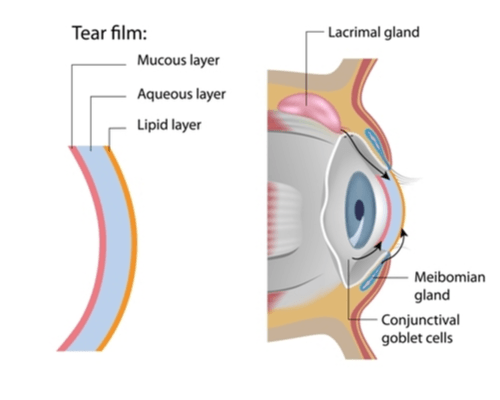DRY EYE
DRY EYE
Overview
Overview
An estimated 16 million Americans have been diagnosed with Dry Eye Disease (DED) but the actual number of people struggling with symptoms is likely much higher with some reports even indicating half of U.S. adults experience dry eye symptoms!
Treatment
Dry Eye Disease is typically treated with a series of staged management and treatment options, which may include:
- Behavioral modifications (changing/modifying environmental factors, taking “blink breaks”, etc)
- Over-the-counter artificial tear supplements and ointments
- Nutritional supplements
- Prescription medications
- Punctal plugs or moisture chamber devices
- Eyelid hygiene, lid cleansers
- Warm compresses
- Lid massage
- Manual lid expression
- Thermal pulsation treatments (therapeutic treatment to unblock clogged Meibomian glands)
- Therapeutic contact lenses
- Amniotic membrane grafts
- In-office, intense pulsed light (IPL)
- Surgical intervention (eg tarsorrhaphy, salivary gland transplantation)
Risk Factors
While the disease can affect both men and women, it is seen predominantly in women. Risk factors for DED include both environmental factors along with medical or medication-related factors. Risk factors include but are not limited to the following:
Environmental:
- Windy conditions, air conditioning, fans
- Exposure to smoke
- Low humidity
- Dry climates
- Extended computer use or screen time/smartphone use
Medical/medications:
- Blood pressure medications
- Anti-depressant medications
- Glaucoma medications
- Rheumatoid arthritis
- Lupus
- Diabetes
- Thyroid disease
- Sjögren’s syndrome
- Contact lens wear
- Previous LASIK surgery
- Previous cataract surgery
- Menopause/Hormone replacement therapy
- Eyelid issues (incomplete blinking, entropion, ectropion, lacrimal obstructions)
With the increase of smartphone and computer use, DED is now affecting younger, even pediatric patients. According to recent study, 66% of ophthalmologists report patients presenting with screen-related eye problems and 88% point to smartphone use as the cause of rising DED prevalence. Dry Eye Disease is even beginning to affect children as young as first grade and has been strongly associated with smartphone use according to a recent study in Korea.
What is Dry Eye Disease and what causes it?
Simply put, Dry Eye Disease is a lack of tears and/or poor quality tears and is often a multifactorial disease. To understand Dry Eye Disease, it is best to understand the components and effects of tear film as both the quality and quantity of tear film can affect the health and vision of the eyes. Each component of the tear film serves an important purpose.
Our tear film is composed of three layers:
Oily layer- produced by the Meibomian glands, this layer helps keep the surface smooth and prevents evaporation.
Watery (or aqueous) layer- produced by the lacrimal glands, this water layer keeps the eye’s surface clean and washes away particles, dust and debris.
Mucus layer- produced by the conjunctiva, this is the innermost layer of tear film which helps spread the watery layer of film over the eye keeping it moist.
The different categories of DED depend upon which component of tear film is affected. The leading cause of DED is Meibomian gland dysfunction and is associated with 86% of DED cases. In this instance, the Meibomian glands do not secrete enough meibum (oil) to prevent the tear film from evaporating too quickly resulting in “evaporative dry eye”. In other cases, the cause of DED is related to the lacrimal glands not producing sufficient watery fluid to keep the eyes moisturized. This is considered “aqueous deficiency dry eye”. It is possible to have a “mixed” form of Dry Eye Disease, which would include both evaporative and aqueous deficiency components.

Signs & Symptoms
Common symptoms of Dry Eye Disease include:
Stinging, burning eyes
Blurry vision, especially while reading
Scratchy, gritty sensation
Foreign body sensation
Red, irritated eyes
Pain while wearing contact lenses
Excessive tearing
Aching/sore eyes
Fatigued eyes
Light sensitivity
Needing to blink excessively to clear vision
As odd as it sounds, excessive tearing is often a sign of dry eyes! Because the eye’s surface is dry it responds to protect itself by over-stimulating the lacrimal glands to produce more tears.
Diagnosis
Diagnosis of Dry Eye Disease is done during examination by an eye doctor but often includes a patient symptom questionnaire. Your eye doctor will evaluate the eye’s surface along with the eye lids, perform a “blink evaluation” and evaluate tear production, quality and quantity.



